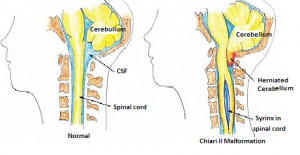Chiari II malformation (also known as Arnold- Chiari malformation)
Chiari II malformation (pronounced Key – ar- ee)is a congenital malformation of the spine and posterior fossa which is commonly seen in children with myelomeningocoele. Children with the Chiari II malformation will have a small posterior fossa (the part of the skull at the back of the head containing the cerebellum) with the result that parts of the cerebellum and brainstem are lower down.
After hydrocephalus, cerebellar and brainstem abnormalities are the next most important part of the Chiari 2 malformation. It is found in almost all children born with Myelomeningocele.

How can Chiari II malformation affect your baby?
Chiari II malformation mainly involves the lower brainstem and lower most portion of the cerebellum, but the layout of the whole brain is also affected. The brainstem contains many of the nerves which control the heart, breathing, blood pressure and help control swallowing, sneezing and coughing. The cerebellum controls the posture and coordination of muscle action to produce precise, coordinated movements.
Your child will have had an MRI to examine the structure of their brain and spinal cord.
When the Chiari II malformation is present, the skull space at the base of the brain is smaller and therefore the brainstem is elongated and displaced downwards into the opening of the base of the skull and top of the spinal canal. The brainstem, cranial nerves and the lower portion of the cerebellum may be stretched or compressed and any of the functions controlled by these areas may be affected.
Chiari II and Hydrocephalus
The malformation might also block the flow of cerebrospinal fluid causing hydrocephalus. Most children with Chiari II malformation have no obvious symptoms and therefore need no treatment
Some children however do develop symptoms (about 5% in our population). You should contact your doctor promptly if your child develops any of these symptoms. Symptoms may be related to faulty shunt function, poorly controlled hydrocephalus or brainstem compression.
Symptoms of Arnold Chiari malformation at different developmental stages
| Infancy | Childhood |
| Stridor (noisy breathing) | Arm tightness or weakness |
| Weak or absent cry | Stiff neck |
| Arching of their neck backwards | Feeding or breathing difficulties |
| Breathing difficulties | Increasing problems with hand eye coordination |
| Feeding or swallowing difficulties | |
| Hypersensitivity to objects in their mouth |
Please note: as your child develops, the symptoms may present differently.
